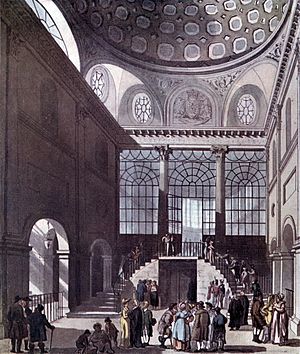Middlesex Quarter Sessions facts for kids
The Middlesex Quarter Sessions was a special court in the historic county of Middlesex, England. It was like a local court that met regularly, usually four times a year, but the Middlesex one met more often. The people who served as judges in this court were called justices of the peace. These were local officials, not always trained lawyers, who helped manage the county.
The court handled some legal cases, but it also had important jobs in running the county. For example, it helped with collecting taxes, issuing licenses, managing prisons, and looking after bridges. This court played a big role in local government from the 1500s until 1889.
Contents
What the Court Covered
The Middlesex Quarter Sessions had a large area it was responsible for. However, its powers sometimes overlapped with another court, the Westminster Quarter Sessions, which covered the City and Liberty of Westminster.
Eventually, in 1844, the Westminster court joined with the Middlesex sessions. This made things simpler. The Middlesex court did not have power over the Liberty of the Tower or the City of London, which had their own separate courts.
When and Where They Met
Because Middlesex was a busy area with many people, its court sessions were different from others. Instead of meeting four times a year, the Middlesex sessions met eight times a year. This helped them keep up with all the work.
The court first met at a place called Hicks Hall in Clerkenwell starting in 1601. However, the April and October meetings would take place at Westminster Hall. Later, a new building called the Middlesex Sessions House was opened in Clerkenwell Green in 1780.
In 1889, the area covered by the Middlesex sessions became smaller when the County of London Quarter Sessions were created. The Middlesex sessions then moved to Westminster Guildhall. The court continued to operate until 1965, when it was replaced by the Greater London Quarter Sessions.
Running the County
From the 1500s, this court was very important for managing Middlesex. Many parts of London were located within Middlesex. The court was in charge of several county tasks.
These tasks included:
- Making sure bridges were kept in good repair.
- Looking after the local prisons.
- Checking and regulating weights and measures used in shops.
- Overseeing the Poor Law, which helped people who were struggling.
As time went on, especially in the 1700s, the court started creating special committees. These committees helped to handle specific county business more efficiently. In 1889, many of these local government duties were passed on to new councils, like the London County Council and the Middlesex County Council.
The Judges
The judges of the Middlesex Quarter Sessions were the justices of the peace. For a long time, these judges did not need to have legal training. This was unusual, as most other courts required their judges to be lawyers.
However, after 1844, it became a rule that the main judge, or chairman, of the Middlesex sessions had to be a legally qualified person.
Famous Chairmen
Some of the people who served as chairmen of the Middlesex Quarter Sessions included:
- George Jeffreys, 1st Baron Jeffreys
- John Hawkins (author) (from 1765 to 1780)
- William Mainwaring (English politician) (from 1781 to 1816)
- Sir John Scott Lillie (1790-1868)
- Sir Ralph Littler (until 1908)
- Montagu Sharpe (from 1909 to 1934)
Court Records
Records from the Middlesex Quarter Sessions that still exist today are kept at the London Metropolitan Archives. These records can tell us a lot about how the county was run and the cases that were heard.


